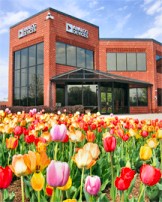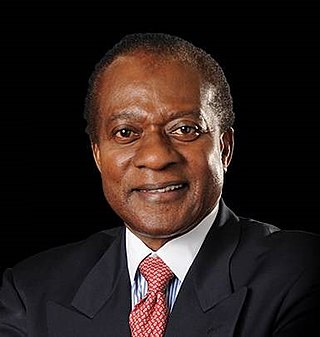
Bell Labs is an American industrial research and development (R&D) company credited with the development of radio astronomy, the transistor, the laser, the photovoltaic cell, the charge-coupled device (CCD), information theory, the Unix operating system, and the programming languages B, C, C++, S, SNOBOL, AWK, AMPL, and others. Ten Nobel Prizes and five Turing Awards have been awarded for work completed at Bell Laboratories.
Digital signal processing (DSP) is the use of digital processing, such as by computers or more specialized digital signal processors, to perform a wide variety of signal processing operations. The digital signals processed in this manner are a sequence of numbers that represent samples of a continuous variable in a domain such as time, space, or frequency. In digital electronics, a digital signal is represented as a pulse train, which is typically generated by the switching of a transistor.

A digital signal processor (DSP) is a specialized microprocessor chip, with its architecture optimized for the operational needs of digital signal processing. DSPs are fabricated on metal–oxide–semiconductor (MOS) integrated circuit chips. They are widely used in audio signal processing, telecommunications, digital image processing, radar, sonar and speech recognition systems, and in common consumer electronic devices such as mobile phones, disk drives and high-definition television (HDTV) products.

Analog Devices, Inc. (ADI), also known simply as Analog, is an American multinational semiconductor company specializing in data conversion, signal processing, and power management technology, headquartered in Wilmington, Massachusetts.

A mixed-signal integrated circuit is any integrated circuit that has both analog circuits and digital circuits on a single semiconductor die. Their usage has grown dramatically with the increased use of cell phones, telecommunications, portable electronics, and automobiles with electronics and digital sensors.
The NEC μPD7720 is the name of fixed point digital signal processors from NEC. Announced in 1980, it became, along with the Texas Instruments TMS32010, one of the most popular DSPs of its day.

Willard Sterling Boyle, was a Canadian physicist. He was a pioneer in the field of laser technology and co-inventor of the charge-coupled device. As director of Space Science and Exploratory Studies at Bellcomm he helped select lunar landing sites and provided support for the Apollo space program.
Arun N. Netravali is an Indian–American computer engineer credited with contributions in digital technology including HDTV. He conducted research in digital compression, signal processing and other fields. Netravali was the ninth President of Bell Laboratories and has served as Lucent's Chief Technology Officer and Chief Network Architect. He received his undergraduate degree from IIT Bombay, India, and an M.S. and a Ph.D. from Rice University in Houston, Texas, all in electrical engineering. Several global universities, including the Ecole Polytechnique Federale in Lausanne, Switzerland, have honored him with honorary doctorates.
The initially called Morris Liebmann Memorial Prize provided by the Institute of Radio Engineers (IRE), the IEEE Morris N. Liebmann Memorial Award was created in 1919 in honor of Colonel Morris N. Liebmann. It was initially given to awardees who had "made public during the recent past an important contribution to radio communications". The award continued to be awarded as the IEEE Morris N. Liebmann Memorial Award by the board of directors of the Institute of Electrical and Electronics Engineers (IEEE) after the IRE organization merged into the IEEE in 1963. The scope was changed to "for important contributions to emerging technologies recognized within recent years". After 2000, the award was superseded by the IEEE Daniel E. Noble Award.
Ian Munro Ross FREng was an early pioneer in transistors, and for 12 years President of Bell Labs.
Stewart E. Miller was a noted American pioneer in microwave and optical communications.
Paul Charles Michaelis was a Bell Labs researcher in magnetic bubble memory.
The AT&T DSP1 was a pioneering digital signal processor (DSP) created by Bell Labs.
Bishnu S. Atal is an Indian physicist and engineer. He is a noted researcher in acoustics, and is best known for developments in speech coding. He advanced linear predictive coding (LPC) during the late 1960s to 1970s, and developed code-excited linear prediction (CELP) with Manfred R. Schroeder in 1985.
Fumitada Itakura is a Japanese scientist. He did pioneering work in statistical signal processing, and its application to speech analysis, synthesis and coding, including the development of the linear predictive coding (LPC) and line spectral pairs (LSP) methods.
The IEEE Eric E. Sumner Award is a Technical Field Award of the IEEE. It was established by the IEEE board of directors in 1995. It may be presented annually, to an individual or a team of not more than three people, for outstanding contributions to communications technology. It is named in honor of Eric E. Sumner, 1991 IEEE President.
Robert W. Brodersen was a professor emeritus of electrical engineering, and a founder of the Berkeley Wireless Research Center (BWRC) at the University of California, Berkeley.
David Albert Hodges (1937–2022) was an American electrical engineer, digital telephony pioneer, and professor of electrical engineering at the University of California, Berkeley.
Lina J. Karam is a Lebanese-American electrical and computer engineer and inventor. She is an IEEE Fellow. Her areas of work span digital signal processing, image/video processing, compression/coding and transmission, computer vision, machine learning/deep learning, perceptual-based visual processing, and automated mobility. She served as an expert delegate of the ISO/IEC JTC1/SC29 Committee and participated in JPEG/MPEG standardization activities. She served as expert consultant in matters related to Intellectual Property (IP)/Patent Litigation, Image/Video Compression and Streaming, Image/Video Processing, Computer Vision, Machine Learning, and Autonomous Driving.

Victor B. Lawrence is a Ghanaian-American engineer credited with seminal contributions in digital signal processing for multimedia communications. During his 30-plus-year tenure at Bell Laboratories, Dr. Lawrence made extensive and fundamental personal contributions to voice, data, audio and video communications. He led numerous projects that significantly improved or enhanced every phase in the evolution of early low-speed and today's high-speed data communications. He is a Research Professor and Director of the Center for Intelligent Networked Systems (iNetS) at Stevens Institute of Technology, where he also served as Associate Dean. He was inducted into the National Inventors Hall of Fame in 2016. He is a Member of the National Academy of Engineering, a Fellow of the IEEE for contributions to the understanding of quantization effects in digital signal processors and the applications of digital signal processing to data communications, a Fellow of AT&T Bell Labs, and a Charter Fellow of the National Academy of Inventors.





